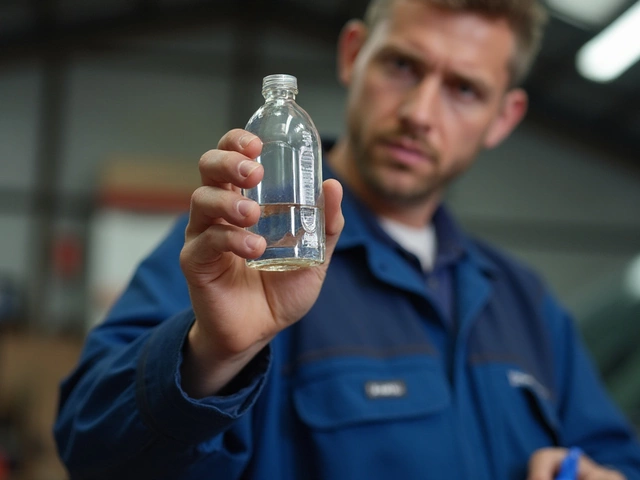Have you ever looked at your car and thought, "I wish this baby had a bit more oomph"? Well, you're not alone. Many drivers seek that extra boost, and one of the most talked-about upgrades is the cold air intake. The big question though—is it just car talk, or does it really pack some horsepower punch?
Let's break it down. The basic idea is simple: cold air is denser than warm air, which means more oxygen for the engine. More oxygen can lead to a better burn and thus, potentially more horsepower. Sounds good on paper, right? But like with most things, reality often lies in the details.
Some folks think you’ll gain massive power from this upgrade, but realistically, the boost is often around 5 to 20 horsepower, depending on the make and model of your machine. Not all cars will see the same gains, and various factors like engine size and existing modifications can play a role.
- Understanding Cold Air Intakes
- The Science Behind Cold Air Intakes
- Horsepower Gains: What to Expect
- Factors Affecting HP Increase
- Installation Tips for Beginners
- Cost vs. Benefit: Is It Worth It?
Understanding Cold Air Intakes
To really get what's happening under the hood with a cold air intake, think about how engines need air to function. Like us, engines breathe. But they don't just want any air, they crave the cool, dense kind. That's where the magic of cold air intakes comes into play.
A typical stock intake system in most cars is designed with efficiency and cost in mind. However, they often draw in air that's already warm from being circulated around the engine bay. A cold air intake system changes this by relocating the engine’s air intake point outside of the toasty engine area. This helps in pulling in colder, denser air, which could contribute to more efficient combustion.
Here are a few key elements of how cold air intakes work:
- Longer Pathways: The design often includes a longer pathway to move the intake point to a cooler part of the engine bay.
- Different Filters: They usually come with improved air filters that allow better airflow compared to stock filters.
- Material Matters: Often made from materials like plastic, carbon fiber, or metal, each affecting the air temperature differently. Plastic improves insulation, whereas metals help in heat dissipation.
Some folks love to chat about how their car sounds post-installing a cold air intake—there can be a noticeable change, often a bit more whoosh and roar. It's not just about performance; for many, the growl is a perk too.
The Science Behind Cold Air Intakes
Alright, let’s dig into how cold air intakes actually work their magic. The principle is quite straightforward: cooler air is denser than hot air, meaning it contains more oxygen per cubic foot. And more oxygen in your engine’s combustion chamber could potentially mean more power.
Your car's engine needs oxygen for combustion, much like how we need it to breathe. The more of it, the better the explosion in the combustion chamber, which translates to more energy. A cold air intake aims to pull in cool, fresh air from outside rather than the warm air from your engine bay, which gets heated up as it circulates.
Here's the catch though: the whole setup relies on positioning. The intake is usually located away from the hot engine parts, often near the fender or grille, where it can pick up that chilled air while you drive.
But it's not just about droppin' in any intake. It's crucial to have a high-quality filter and a properly sized tube to help smooth the airflow. The right components work together to reduce restrictions and increase the volume of air reaching the combustion chamber.
There's also the material aspect. Most intakes are made of metal or plastic, but metal ones might heat up quicker, sometimes defeating the purpose of cooling the air. So, it’s about striking the right balance.
When you combine all these elements, you've got a system that can make your car breathe better. And while you’re not going to double your horsepower, a well-installed cold air intake can boost performance and even improve fuel economy a bit. Every little helps, right?
Horsepower Gains: What to Expect
Alright, let's get to the nitty-gritty. If you're thinking about adding a cold air intake to your car, you're probably curious about the horsepower boost you can expect. It's not magic, but when done right, it can give your car noticeable pep.
In most cases, adding a cold air intake can give you anywhere from 5 to 20 extra horsepower, which for some folks might not sound like much, but trust me, you’ll feel it. Cars, especially those with larger engines like V6 or V8, tend to benefit more due to their ability to utilize additional air efficiently.
A big influencer on those gains is, of course, the current setup of your car. If your vehicle is completely stock, the improvements might be at the lower end of the spectrum. But if you've got other performance mods, say a high-performance exhaust or a tuned ECU, the cold air intake might just be the missing link to elevate your car's performance.
Sometimes, folks get all jazzed up expecting a massive transformation immediately after installation. But keep in mind, the horsepower boost can vary depending on factors like the quality of the air intake system you buy, how well it integrates with your existing setup, and even the climate where you usually drive.
Here’s a useful tip: compare different brands and read owner reviews like you're digging for gold. Not all cold air intakes are created equal. Some come with features like a heat shield or a better air filter, which can make a decent difference.
Let's spice things with some data:
| Vehicle Type | Estimated HP Gain |
|---|---|
| Sedan (4-cylinder) | 5-10 HP |
| SUV (6-cylinder) | 10-15 HP |
| Truck (8-cylinder) | 15-20 HP |
So, while we're not talking about racecar-level improvements, a cold air intake can definitely give your car a nice little tune-up. And hey, every bit counts when you just want that little extra push when you're merging onto the freeway or simply want to enjoy a more engaging drive!

Factors Affecting HP Increase
When it comes to how much horsepower your cold air intake might add, it isn't a clear-cut answer. Several factors come into play, and even the most experienced gearheads will tell you that it's a bit of a gamble. Let's dive into what can actually make a difference.
First off, the type of engine matters a lot. A high-displacement engine typically benefits more because it can make use of the extra air more effectively. If you've got a turbocharged machine, chances are you’ll see more noticeable gains as these engines are built to compress air.
Another big factor is the existing condition of your car. If your exhaust system is all clogged up or the air filter's choking—well, a cold air intake might not be your miracle worker. The car's whole system needs to be able to accommodate the extra air.
"A cold air intake can provide notable gains, but only if your engine is set up to reap the benefits," says Jake Miller, an automotive performance specialist.
Then there's the tuning aspect. A lot of people forget that the ECU—kind of like the brain of your car—might need a bit of a tweak to really harness the potential of that extra cool air swishing through. Sometimes, a professional tuning can give you those few extra horses you’re looking for.
- Type of Engine: High-displacement and turbocharged engines gain more.
- Existing Car Condition: A well-maintained exhaust system and air intake bode better results.
- ECU Tuning: Needed for optimizing air and fuel mix.
Finally, let's talk about the quality of the cold air intake system itself. Not all kits are made equal. Investing in a well-designed system with a reputable brand can make all the difference in world.
Installation Tips for Beginners
Thinking about diving into the world of car mods with a cold air intake? It's a great first step, but getting it right can make all the difference. Let's keep it simple and get you started on the right foot.
First off, make sure you have the right kit for your car model. Not all intakes are created equal, and getting a mismatched one can lead to all sorts of issues, from fit to performance. Once you have the right kit, you'll also need a few basic tools: a screwdriver, some pliers, and a socket set should do the trick.
Here’s a step-by-step guide to help you through the process:
- Disconnect the Battery: Safety first! Before you start tinkering, unplug the car battery to avoid any electrical mishaps.
- Remove the Old Intake: Unclip the airbox and gently remove it along with the tubing. Be careful with the sensors; they're important and can be fragile.
- Install the New Cold Air Intake: Follow the instructions that come with your kit. Typically, you'll attach the new intake pipe using clamps and fit it into place where the old one used to be.
- Secure and Fasten: Make sure everything is tight and snug. Loose fittings can cause inefficiencies or even damage over time.
- Reconnect the Battery: Once you're certain everything is in place, plug the battery back in and give your ride a test start.
Pro tip: Run your engine for a bit and listen for any strange noises. If you hear anything unusual, double-check your installation.
Thinking about buying some performance data? Here's a little insight: some users report a slight improvement in fuel efficiency alongside horsepower gains. This isn't always the case, but it's a nice little bonus if you get it.
And there you have it—a not-so-daunting task with some pretty sweet rewards. Remember, it's less about the power you gain and more about understanding how to tweak and improve your driving experience. Plus, there's something cool about saying you upgraded your car's cold air intake yourself!
Cost vs. Benefit: Is It Worth It?
Cold air intakes might not break the bank, but they're not pocket change either. So, is this car performance upgrade really worth it? Let's crunch some numbers and see what's what.
A quality cold air intake system generally ranges from $150 to $500, depending on your car model and the brand you're eyeing. Sure, that might seem like a lot when you're just hoping to squeeze out an extra 5 to 20 horsepower, but don't dismiss it just yet.
"Investing in a cold air intake is about more than just horsepower. It’s also about efficiency and engine sound, which can seriously enhance the driving experience," says auto expert Jason Munroe, founder of Torque Hub.
Installation can often be a DIY project, saving you money on labor costs. But if you're not confident with a wrench, professional installation will add to your expenses.
- Pros: Potential increase in horsepower and torque, improved throttle response, nicer engine sound, and they usually come with reusable filters, which means less on maintenance over time.
- Cons: Initial cost, potential complexity of installation, and possible need for other mods to really feel the power difference.
Bottom line? If you're looking for a noticeable improvement in power or sound without going full throttle with engine overhauls, a cold air intake fits the bill. But if you’re only expecting massive horsepower gains, you might want to manage those expectations.






